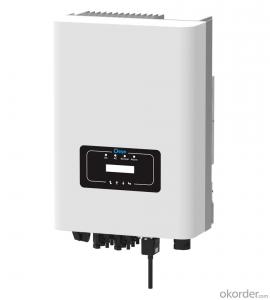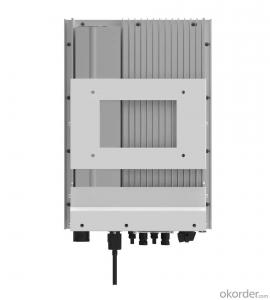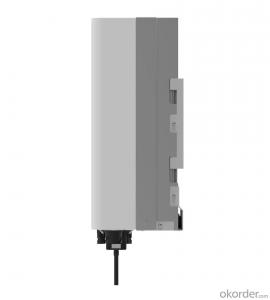SUN-18/20/25K-G04 | 18-25KW | Three Phase | 2 MPPT
- Loading Port:
- Ningbo
- Payment Terms:
- TT OR LC
- Min Order Qty:
- 100 pc
- Supply Capability:
- 5000 pc/month
OKorder Service Pledge
Quality Product, Order Online Tracking, Timely Delivery
OKorder Financial Service
Credit Rating, Credit Services, Credit Purchasing
You Might Also Like
Item specifice
Output Power:
18-25kw
Inveter Efficiency:
97.8%
Output Voltage(V):
380
Input Voltage(V):
550
Output Current(A):
26.1-36.2
Output Frequency:
50/60Hz
| Technical Data | |||||
| Model | SUN-18K-G04 | SUN-20K-G04 | SUN-25K-G04 | ||
| Input Side | |||||
| Max. DC Input Power (kW) | 23.4 | 26 | 32.5 | ||
| Max. DC Input Voltage (V) | 1000 | ||||
| Start-up DC Input Voltage (V) | 250 | ||||
| MPPT Operating Range (V) | 200~850 | ||||
| Max. DC Input Current (A) | 32+32 | ||||
| Max. Short Circuit Current (A) | 48+48 | ||||
| Number of MPPT / Strings per MPPT | 2/2 | ||||
| Output Side | |||||
| Rated Output Power (kW) | 18 | 20 | 25 | ||
| Max. Active Power (kW) | 19.8 | 22 | 27.5 | ||
| Nominal Output Voltage / Range (V) | 3L/N/PE 380V/0.85Un-1.1Un, 400V/0.85Un-1.1Un | ||||
| Rated Grid Frequency (Hz) | 50 / 60 (Optional) | ||||
| Operating Phase | Three phase | ||||
| Rated AC Grid Output Current (A) | 26.1 | 29 | 36.2 | ||
| Max. AC Output Current (A) | 28.7 | 31.9 | 39.8 | ||
| Output Power Factor | 0.8 leading to 0.8 lagging | ||||
| Grid Current THD | <3%< span=""> | ||||
| DC Injection Current (mA) | <0.5%< span=""> | ||||
| Grid Frequency Range | 47~52 or 57~62 (Optional) | ||||
| Efficiency | |||||
| Max. Efficiency | 98.6% | ||||
| Euro Efficiency | 97.8% | ||||
| MPPT Efficiency | >99% | ||||
| Protection | |||||
| DC Reverse-Polarity Protection | Yes | ||||
| AC Short Circuit Protection | Yes | ||||
| AC Output Overcurrent Protection | Yes | ||||
| Output Overvoltage Protection | Yes | ||||
| Insulation Resistance Protection | Yes | ||||
| Ground Fault Monitoring | Yes | ||||
| Anti-islanding Protection | Yes | ||||
| Temperature Protection | Yes | ||||
| Integrated DC Switch | Yes | ||||
| Remote software upload | Yes | ||||
| Remote change of operating parameters | Yes | ||||
| Surge protection | DC Type II / AC Type II | ||||
| General Data | |||||
| Size (mm) | 330W×508H×206D | ||||
| Weight (kg) | 20.8 | ||||
| Topology | Transformerless | ||||
| Internal Consumption | <1W (Night) | ||||
| Running Temperature | -25~65℃, >45℃ derating | ||||
| Ingress Protection | IP65 | ||||
| Noise Emission (Typical) | <45 dB | ||||
| Cooling Concept | Smart cooling | ||||
| Max. Operating Altitude Without Derating | 2000m | ||||
| Warranty | 5 years | ||||
| Grid Connection Standard | CEI 0-21, VDE-AR-N 4105, NRS 097, IEC 62116, IEC 61727, G99, G98, VDE 0126-1-1, RD 1699, C10-11 | ||||
| Operating Surroundings Humidity | 0-100% | ||||
| Safety EMC / Standard | IEC/EN 61000-6-1/2/3/4, IEC/EN 62109-1, IEC/EN 62109-2 | ||||
| Features | |||||
| DC Connection | MC-4 mateable | ||||
| AC Connection | IP65 rated plug | ||||
| Display | LCD1602 | ||||
| Interface | RS485/RS232/Wifi/LAN | ||||
This new series of three-phase output inverter has wider range of 18kw, 20kw, 25kw than the original series, at the same time still got two integrated MPPTs, allowing two-array to input from different roof orientations. In addition, it allows the system to be monitored and controlled remotely.
2 MPP tracker, Max. efficiency up to 98.6%
Zero export application, VSG application
String intelligent monitoring (optional)
Wide output voltage range
Anti-PID function (Optional)
- Q:What is the difference between a transformerless inverter and a transformer-based inverter?
- A transformerless inverter and a transformer-based inverter differ primarily in their design and functionality. A transformerless inverter, as the name suggests, does not incorporate a transformer in its circuitry. It uses advanced electronic components and techniques to convert direct current (DC) into alternating current (AC). This makes it more compact, lightweight, and cost-effective compared to transformer-based inverters. However, it may have limitations in terms of voltage isolation and grounding. On the other hand, a transformer-based inverter includes a transformer in its design. This allows for voltage transformation, isolation, and improved grounding capabilities. It provides better protection against electrical surges, noise, and voltage fluctuations. However, transformers add weight, increase size, and are more expensive compared to transformerless inverters. The choice between a transformerless and a transformer-based inverter depends on the specific requirements of the application. Transformerless inverters are commonly used in residential solar power systems, while transformer-based inverters are often preferred for industrial or commercial applications where higher power levels and enhanced protective features are necessary.
- Q:What certifications should I look for when choosing a solar inverter?
- When choosing a solar inverter, it is important to look for certifications such as IEC 62109 or UL 1741. These certifications ensure that the inverter meets necessary safety and performance standards. Additionally, certifications like ISO 9001 indicate that the manufacturer follows quality management systems.
- Q:What is the role of a solar inverter in power factor correction?
- The role of a solar inverter in power factor correction is to adjust the power factor of the solar power system to ensure efficient energy conversion. It helps in balancing the reactive power and real power, leading to improved overall power quality and reduced system losses.
- Q:What is the role of a power limiter in a solar inverter?
- The role of a power limiter in a solar inverter is to regulate and control the amount of power being fed into the grid from the solar panels. It ensures that the power output from the solar panels does not exceed the predetermined limit set by the utility company or regulatory standards. This helps prevent overloading of the grid and ensures the safe and efficient operation of the solar power system.
- Q:What is the role of a solar inverter in a solar-powered desalination system?
- The role of a solar inverter in a solar-powered desalination system is to convert the direct current (DC) electricity generated by the solar panels into alternating current (AC) electricity that can be used to power the desalination equipment. The inverter ensures efficient and safe power conversion, allowing the system to effectively utilize the energy generated by the solar panels for the desalination process.
- Q:How do you connect a solar inverter to solar panels?
- To connect a solar inverter to solar panels, the DC output of the solar panels needs to be connected to the DC input of the inverter. This is usually done using appropriately sized and rated solar cables and connectors. The positive terminal of the solar panel is connected to the positive terminal of the inverter, and the negative terminal of the solar panel is connected to the negative terminal of the inverter. Properly following the manufacturer's instructions and guidelines is crucial to ensure a safe and efficient connection.
- Q:Can a solar inverter be used with a solar-powered street lighting system?
- Yes, a solar inverter can be used with a solar-powered street lighting system. A solar inverter is responsible for converting the DC power generated by solar panels into AC power, which is necessary for powering street lights. By integrating a solar inverter, the solar-powered street lighting system can efficiently convert and utilize the energy generated by the solar panels, ensuring the proper functioning of the lights.
- Q:How does a solar inverter affect the overall energy consumption of a property?
- A solar inverter affects the overall energy consumption of a property by converting the direct current (DC) electricity produced by solar panels into alternating current (AC) electricity that can be used to power electrical appliances and equipment in the property. It ensures that the electricity generated by the solar panels is compatible with the property's electrical system, reducing the dependence on grid-supplied electricity. By efficiently converting solar energy into usable electricity, a solar inverter helps to lower the property's energy consumption from traditional sources and can potentially result in energy cost savings.
- Q:Can a solar inverter be used with a portable solar panel system?
- Yes, a solar inverter can be used with a portable solar panel system. The solar inverter converts the direct current (DC) generated by the portable solar panels into alternating current (AC) that can be used to power various devices or be fed into the electrical grid. This allows for the efficient utilization of the energy generated by the portable solar panel system.
- Q:What is the power factor correction capability of a solar inverter?
- The power factor correction capability of a solar inverter refers to its ability to adjust and optimize the power factor of the electricity it generates. This is important because a low power factor can cause inefficiencies and increase energy consumption. A good solar inverter should have a high power factor correction capability, meaning it can actively correct and improve the power factor, resulting in a more efficient utilization of electricity and reduced energy wastage.
1. Manufacturer Overview |
|
|---|---|
| Location | |
| Year Established | |
| Annual Output Value | |
| Main Markets | |
| Company Certifications | |
2. Manufacturer Certificates |
|
|---|---|
| a) Certification Name | |
| Range | |
| Reference | |
| Validity Period | |
3. Manufacturer Capability |
|
|---|---|
| a)Trade Capacity | |
| Nearest Port | |
| Export Percentage | |
| No.of Employees in Trade Department | |
| Language Spoken: | |
| b)Factory Information | |
| Factory Size: | |
| No. of Production Lines | |
| Contract Manufacturing | |
| Product Price Range | |
Send your message to us
SUN-18/20/25K-G04 | 18-25KW | Three Phase | 2 MPPT
- Loading Port:
- Ningbo
- Payment Terms:
- TT OR LC
- Min Order Qty:
- 100 pc
- Supply Capability:
- 5000 pc/month
OKorder Service Pledge
Quality Product, Order Online Tracking, Timely Delivery
OKorder Financial Service
Credit Rating, Credit Services, Credit Purchasing
Similar products
New products
Hot products
Related keywords
































